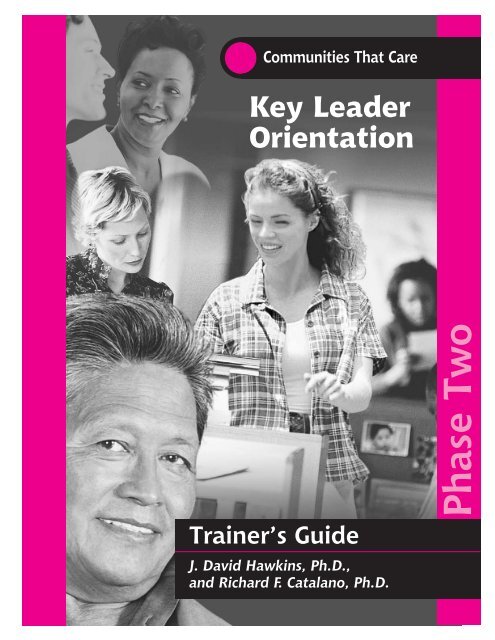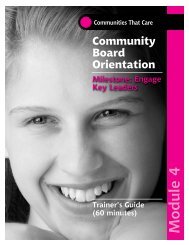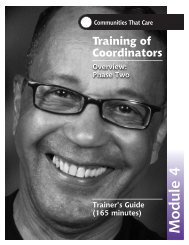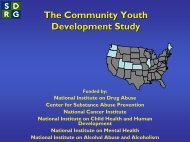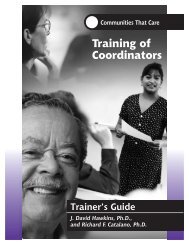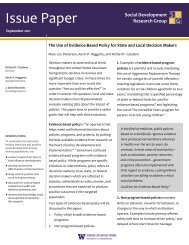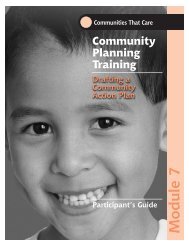KLO Training Guide Module 1
KLO Training Guide Module 1
KLO Training Guide Module 1
- No tags were found...
Create successful ePaper yourself
Turn your PDF publications into a flip-book with our unique Google optimized e-Paper software.
Communities That CareKey LeaderOrientationTrainer’s <strong>Guide</strong>J. David Hawkins, Ph.D.,and Richard F. Catalano, Ph.D.Phase Two
Contents of Trainer’s <strong>Guide</strong><strong>Module</strong> 1:<strong>Module</strong> 2:<strong>Module</strong> 3:<strong>Module</strong> 4:<strong>Module</strong> 5:<strong>Module</strong> 6:Setting the StageThe Research FoundationThe Implementation ProcessBenefits and ResultsCommitting to the Communities That Care ProcessNext StepsAppendix 1: ReferencesAppendix 2: Communities That Care Milestones and Benchmarksiii
IntroductionGoalsThe goals of this orientation are to give community leaders:• an overview of the Communities That Care prevention-planning system• an understanding of how the community can benefit from using this science-based system to guideprevention-planning and implementation efforts.ObjectivesAfter completing this orientation, participants will be able to:• explain the Communities That Careresearch foundation• describe the Communities That Careimplementation process• identify how children, families andthe community will benefit from theCommunities That Care system• commit to the Communities That Care process,including use of the Communities That Care YouthSurvey• describe how Key Leaders support theCommunities That Care system• plan for the next steps in the CommunitiesThat Care process.AudienceThe participants in the Key Leader Orientation will be formal and informal community leaders and stakeholders.They may include mayors, business leaders, education leaders, lead law enforcement officials, religious andcultural leaders and leaders of civic groups and foundations. These individuals provide leadership, directresources and shape opinions in the community. Stakeholders may provide key leadership and influence at agrass-roots level in the community. Community leaders are those few individuals whose support for theprocess is required for successful implementation of the process.AgendaTotal training time including breaks is approximately 4 hours, 30 minutes.<strong>Module</strong> 1Setting the Stage(30 minutes)<strong>Module</strong> 2The Research Foundation(90 minutes)<strong>Module</strong> 3The Implementation Process(30 minutes)<strong>Module</strong> 4Benefits and Results(30 minutes)<strong>Module</strong> 5Committing to the Communities That Care Process(30 minutes)<strong>Module</strong> 6Next Steps(60 minutes)iv
Communities That CarePre-training preparationMaterials to be sent to the Coordinator/Facilitator:• list of audiovisual, beverage and snack needs• recommended room setup• copies of Investing in Your Community’s Youth: An Introduction to theCommunities That Care System, for participants to review before the training.Equipment and materials:• name tags• roster of invitees• copies of any letters or notices sent to invitees• computer projector and laptop computer and/oroverhead projector and transparencies• flip chart/easel• markers• tape• Post-it ® notes (4" x 6").Room setup:• If the group is large, the room should be set up with round tables of six toaccommodate small-group work. Place tables so all participants can see thefront of the room.• Provide drinking water at each table and a refreshment table in the back of the room.• Place a small table for the computer or overhead projector at the front of the room.The projection screen should be large enough for all participants to see the slides.• Place trainer, registration and resource tables in convenient locations.At least 60 minutes before start time:• Set up a table for name tags, registration materials and participant materials. Makesure participant materials are complete and organized.• Set up training equipment.• Place an easel sheet at the entrance with the message: “Welcome to theCommunities That Care Key Leader Orientation.”• Pre-print an easel sheet with a “Parking Lot” headline and two columns, one labeled“Questions” and the other labeled “Issues.”• Pre-print an easel sheet for each table that reads “Call to Action.” Place a sheet anda marker on each table.v
Pre-training preparationFor <strong>Module</strong> 1:If possible, have the Communities That Care Championbegin the orientation—welcoming participants, giving abrief history of activities to date (including keyparticipants involved so far) and expressing support forthe process. Work with the Coordinator/Facilitator whenscheduling the orientation to ensure that a Championhas been identified and that he or she is aware of whatto cover, when to arrive and how much time is allotted.For <strong>Module</strong> 5:Contact the Coordinator/Facilitator and arrange for himor her to follow up on securing commitments from KeyLeaders. The Coordinator/Facilitator should plan tocontact participants the week after the training.For <strong>Module</strong> 6:Contact the Coordinator/Facilitator and gatherinformation on readiness work to date and outstandingissues. Arrange for someone from the site(Coordinator/Facilitator, Champion, etc.) to share thisinformation with the Key Leaders. Also, arrange forsomeone from the site to discuss the results of the KeyAspects Summary and Outstanding Planning Issuesworksheets (from Tools for Community Leaders: A<strong>Guide</strong>book for Getting Started).Be familiar with the Phase One milestones andbenchmarks (in Appendix 2).Please remember to complete a Service Report forthis training.vi
Communities That CareKey LeaderOrientationSetting the StageTrainer’s <strong>Guide</strong>(30 minutes)<strong>Module</strong> 1
Slides for <strong>Module</strong> 1Key Leader Orientation................................................... 1-1<strong>Module</strong> 1......................................................................... 1-2A call to action ................................................................ 1-3Key Leader Orientation goals......................................... 1-4Objectives ....................................................................... 1-5Agenda ........................................................................... 1-6Ground rules................................................................... 1-7The Communities That Care system............................... 1-8Phase Two: Organizing, Introducing, Involving ............. 1-9Mouse-Click Icon(for a computer-based presentation)The mouse-click icon shows you what information will come up on theslide when you click. (Some slides use several clicks.)1—2
Communities That CareSlide 1-1NotesWelcome participants as they enter.1—3
<strong>Module</strong> 1Setting the Stage30minutesObjectivesParticipants will:• learn what has been done to date to start the Communities That Care process in their community• become familiar with each trainer’s relevant background and experience• understand the goals, objectives and agenda.Slide 1-2NotesThe Champion opens the training.The Champion:• welcomes participants and thanks them for attending• gives a brief overview of the Communities That Care process to date• publicly states his or her commitment to the Communities That Careprocess, including use of the Communities That CareYouth Survey• describes the role he or she will play in implementing the CommunitiesThat Care system• introduces the training team.1—4
Communities That CareIntroductionsIntroduce yourself and tell participants:• your professional background• your favorite thing about the community in which you live.Tell participants that you would like to get a sense of what parts of the community they represent. Ask participants tostand when they hear the stakeholder group they will represent in the Communities That Care process:• local government• education• law enforcement• business• youth programs/services• parents• social services• faith community• cultural/ethnic groups• justice system/courts• health services• media• other.It’s wonderful to see so many of these important stakeholder groups represented in this orientation. We know from theresearch and from our experience that involving all parts of the community that influence young people’s lives is criticalto the success of the Communities That Care process.1—5
<strong>Module</strong> 1Slide 1-3NotesActivityA call to actionTime: 10 minutesHave participants work in teams at their tables to discuss the question on the slide. Ask each team to choose a recorder tocapture the team’s thoughts on an easel page.Allow about 8 minutes for discussion.Walk among the tables as teams discuss the question. Pay attention to the things people are saying. Note any mentions ofgood things that young people are doing.After 8 minutes, have one or two groups share their responses.From the comments that have been shared, and from what I heard during your discussions, it’s interesting to note how manycomments focused on things you would like to change—things that are viewed as problems in your community. I’m guessingthat isn’t the complete picture.Are the young people in your community doing any positive things? Of course they are. But we generally lack the motivation toact when everything is going well. We often need a catalyst—a call to action—to change our behavior. In communities, thenegative behaviors many of you mentioned often serve as that call to action.But recognizing the challenges or problems facing young people in your community does not discount your community’s manystrengths. Confronting these challenges can mobilize your community to identify and use its strengths to effectively address theconditions that can interfere with positive youth development.The lists you developed represent the “right now” for your community. Clearly the “right now” isn’t good enough—you wouldn’tbe here if it were. During the next several hours, we’re going to discuss the Communities That Care prevention-planningsystem. The Communities That Care system can help promote positive development among the young people in yourcommunity—helping your community move from where it is right now to where you want it to be.1—6
Communities That CareSlide 1-4NotesReview the slide.1—7
<strong>Module</strong> 1Slide 1-5NotesReview the slide.1—8
Communities That CareSlide 1-6NotesAgenda ReviewReview the slide.Note: Since the amount of time available for the Key Leader Orientation variesgreatly in different communities, you may wish to post a more detailed agenda.Housekeeping Items• Explain where the restrooms and telephones are located.• Ask participants to turn off their cell phones or beepers.• Explain that the “Parking Lot” will be used to capture any questions orissues that come up during the training but can’t be addressed at that time.Tell the group you will revisit the Parking Lot at the end of the training tomake a plan for addressing any unresolved questions or issues.• Discuss any other items, such as breaks and refreshments.Participant’s <strong>Guide</strong>Ask participants to open their guides. Explain that the guide has:• copies of all slides, with space to record notes• worksheets for group activities and planning• appendices containing references, additional background informationand ideas for getting members of your community involved in yourprevention-planning efforts.Tell participants that the pocket of the guide contains:• a <strong>Training</strong> Evaluation form• a laminated page with a chart of the risk factors on one side and a diagramof the Social Development Strategy on the other.Ask if there are any questions about the guide.1—9
<strong>Module</strong> 1Slide 1-7NotesGround RulesReview the slide.Label an easel sheet “Ground Rules.”Ask the group to brainstorm any other rules they would like to use for thissession. Write these rules on the easel sheet.Ask for a commitment to observe the ground rules.1—10
Communities That CareSlide 1-8NotesReview the slide.For anyone who may not be familiar with the Communities That Careprevention-planning system, I’ll give a quick overview.The Communities That Care system is a unique community action model,based on years of research and continuous improvement. It helps acommunity design, carry out and evaluate a Community Action Plan forprevention that is matched to its specific needs. It provides a way for acommunity to use its funding and other resources as efficiently as possiblewith the highest probability of success.The Communities That Care system provides a unifying framework topromote the healthy development of young people. It brings together a widerange of people, programs and initiatives to address youth issues in acomprehensive way.Every community is unique. The Communities That Care system relies ona thorough assessment of the community’s risk and protective factors andresources. This information is used to help identify existing communityefforts that address youth issues and gaps where prevention efforts are stillneeded. The Communities That Care system helps your community selecttested, effective programs, policies and practices to meet its uniqueprevention needs.1—11
<strong>Module</strong> 1Slide 1-9NotesReview the slide.1—12


